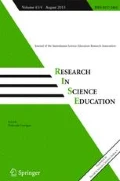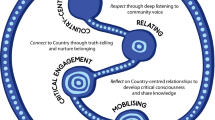Abstract
Developing students’ skills to pose and respond to questions and actively engage in inquiry behaviours enables students to problem solve and critically engage with learning and society. The aim of this study was to analyse the impact of providing teachers with an intervention in inquiry pedagogy alongside inquiry science curriculum in comparison to an intervention in non-inquiry pedagogy alongside inquiry science curriculum on student questioning and other inquiry behaviours. Teacher participants in the comparison condition received training in four inquiry-based science units and in collaborative strategic reading. The experimental group, the community of inquiry (COI) condition, received training in facilitating a COI in addition to training in the same four inquiry-based science units. This study involved 227 students and 18 teachers in 9 primary schools across Brisbane, Australia. The teachers were randomly allocated by school to one of the two conditions. The study followed the students across years 6 and 7 and students’ discourse during small group activities was recorded, transcribed and coded for verbal inquiry behaviours. In the second year of the study, students in the COI condition demonstrated a significantly higher frequency of procedural and substantive higher-order thinking questions and other inquiry behaviours than those in the comparison condition. Implementing a COI within an inquiry science curriculum develops students’ questioning and science inquiry behaviours and allows teachers to foster inquiry skills predicated by the Australian Science Curriculum. Provision of inquiry science curriculum resources alone is not sufficient to promote the questioning and other verbal inquiry behaviours predicated by the Australian Science Curriculum.

Similar content being viewed by others
References
Abd-el-khalick, F. (2008). Modeling science classrooms after scientific laboratories. In R. A. Duschl & R. E. Grandy (Eds.), Teaching scientific inquiry: recommendations for research and implementation (pp. 80–85). Rotterdam: Sense.
Australian Curriculum, Assessment and Reporting Authority (ACARA). (2014a). Australian Curriculum: critical and creative thinking. Retrieved from http://www.australiancurriculum.edu.au/GeneralCapabilities/Pdf/Critical-and-creative-thinking.
Australian Curriculum, Assessment and Reporting Authority (ACARA). (2014b). Australian Curriculum: science. Retrieved from http://www.australiancurriculum.edu.au/science/curriculum/f-10?layout=1.
Baumfield, V. (2006). Tools for pedagogical inquiry: the impact of teaching thinking skills on teachers. Oxford Review of Education, 32(2), 185–196.
Blanchard, M. R., Southerland, S. A., Osborne, J. W., Sampson, V. D., Annetta, L. A., & Granger, E. M. (2010). Is inquiry possible in light of accountability: a quantitative comparison of the relative effectiveness of guided inquiry and verification laboratory instruction. Science Education, 84, 577–610.
Brickhouse, N. (2008). What is inquiry? To whom should it be authentic? In R. A. Duschl & R. E. Grandy (Eds.), Teaching scientific inquiry: recommendations for research and implementation (pp. 284–303). Rotterdam: Sense.
Burgh, G., & Nichols, K. (2012). The parallels between philosophical inquiry and scientific inquiry: implications for science education. Educational Philosophy and Theory, 44(10), 1045–1059.
Burgh, G., & O’Brien, M. (2002). Philosophy and education: integrating curriculum, teaching and learning. Critical and Creative Thinking: The Australasian Journal of Philsophy for Children, 10(1), 45–58.
Burgh, G., Freakley, M., & Field, T. (2006). Ethics and the community of inquiry: education for deliberative democracy. Southbank: Thomson Social Sciences, 154.
Bybee, R. W. (2006). Enhancing science teaching and student learning: a BSCS perspective. Boosting science learning: what it will take? ACER research conference. Review of Educational Research, 64, 1–35.
Cam, P. (2006). Twenty thinking tools: collaborative inquiry for the classroom. Camberwell: Australian Council for Educational Research.
Crawford. (2012). Moving the essence of inquiry into the classroom: engaging teachers and students in authentic science. In K. C. D. Tan & M. Kim (Eds.), Issues and challenges in science education research: moving forward. New York: Springer Science and Business Media.
Daniel, M.-F., & Auriac, E. (2011). Philosophy, critical thinking and philosophy for children. Educational Philosophy and Theory, 43(5), 415–435.
Edelson, D. C. (2008). Engineering pedagogical reform. In R. A. Duschl & R. E. Grandy (Eds.), Teaching scientific inquiry: recommendations for research and implementation (pp. 164–181). Rotterdam: Sense.
Facione, P. A. (1990). Critical thinking: a statement of expert consensus for purposes of educational assessment and instruction. The Delphi research report. California: Santa Clara University.
Gall, M. D. (1970). The use of questions in teaching. Review of Educational Research, 40(5), 707–721.
Gamoran, A., Anderson, C. W., Quiroz, P. A., Secada, W. G., Williams, T., & Ashmann, S. (2003). Transforming teaching in math and science: how schools and districts can support change. New York: Teachers College.
Garcia-Moriyon, F., Rebollo, I., & Colom, R. (2005). Evaluating philosophy for children: a meta-analysis. Critical and Creative Thinking: The Journal of Philsophy for Children, 17(4), 14–22.
Gay, L. R., & Airasian, P. (2000). Educational research: competencies for analysis and application (6th ed.). NJ: Prentice Hall.
Gillies, R., Nichols, K., Burgh, G., & Hayes, M. (2014). Primary students’ scientific reasoning and discourse during cooperative inquiry-based science activities. International Journal of Educational Research, 63, 127–140.
Grigg, J., Kelly, K. A., Gamoran, A., & Borman, G. D. (2012). Effects of two scientific inquiry professional development interventions on teaching practice. Educational Evaluation and Policy Analysis, 35(1), 38–56.
Johnson, D. W., & Johnson, R. T. (1990). Cooperative learning and achievement. In S. Sharan (Ed.), Cooperative learning: theory and research (pp. 23–37). New York: Praeger.
Keys, C. W., & Bryan, L. A. (2001). Co-constructing inquiry-based science with teachers: essential research for lasting reform. Journal of Research in Science Teaching, 38(6), 631–645.
Kraska, M. (2010). Multivariate analysis of variance (MANOVA). In N. J. Salkind (Ed.), Encyclopedia of research design (pp. 858–863). Thousand Oaks: Sage.
Laxman, K. (2013). Infusing inquiry-based learning skills in curriculum implementation. International Journal for Lesson and Learning Studies, 2(1), 41–55.
Lee, O., Hart, J. E., Cuevas, P., & Enders, C. (2004). Professional development in inquiry-based science for elementary teachers of diverse student groups. Journal of Research in Science Teaching, 41(10), 1021–1043.
Lipman, M. (1988). Philosophy goes to school. Philadelphia: Temple University.
Lipman, M. (1991). Thinking in education. Cambridge: Cambridge University.
Lipman, M. (1993). Promoting better classroom thinking. Educational Psychology, 13(3–4), 291–304.
Lou, Y., Abrami, P. C., Spence, J. C., Poulsen, C., Chambers, B., & d’Apollonia, S. (1996). Within-class grouping: a meta-analysis. Review of Educational Research, 66(4), 423–458.
Lucas, D., Broderick, N., Lehrer, R., & Bohanan, R. (2005). Making the grounds of scientific inquiry visible in the classroom. Science Scope, 29(3), 39–42.
Mercer, N., Dawes, L., & Staarman, J. K. (2009). Dialogic teaching in the primary science classroom. Language and Education, 23(4), 353–369.
Millett, S., & Tapper, A. (2012). Benefits of collaborative philosophical inquiry in schools. Educational Philosophy and Theory, 44(5), 546–567.
Ministerial Council on Education, Employment, Training and Youth Affairs (MCEETYA). (2008). Melbourne declaration on educational goals for young Australians. Retrieved http://www.curriculum.edu.au/verve/_resources/National_Declaration_on_the_Educational_Goals_for_Young_Australians.pdf.
Morris, S. B., & DeShon, R. P. (2002). Combining effect size estimates in meta-analysis with repeated measures and independent groups designs. Psychological Methods, 7(1), 105–125.
National Curriculum Board. (2009). Shape of the Australian Curriculum: Science. Canberra, Australia: Commonwealth of Australia. Retrieved from http://www.acara.edu.au/verve/_resources/the_shape_of_the_australian_curriculum_v4.pdf.
Neuman, W. L. (2004). Basics of social research: qualitative and quantitative approaches. Boston: Pearson Education.
Paul, R. (1990). Critical and reflective thinking: a philosophical perspective. In B. F. Jones & L. Idol (Eds.), Dimensions of thinking and cognitive instruction (pp. 447–495). Hillsdale: Lawrence Erlbaum Associates.
Reinsvold, L. A. (2011). Power dynamics and questioning in elementary science lesson. (Doctoral dissertation, University of Northern Colorado). Retrieved from http://search.proquest.com.ezproxy.library.uq.edu.au/docview/919538430?pq-origsite=summon.
Scholl, R., Nichols, K., & Burgh, G. (2009). Philosophy for children: towards pedagogical transformation. In the Proceedings for the Annual Australian Teacher Education Association. Published online at http://atea.edu.au/ConfPapers/2009/Refereed/Scholl.pdf.
Scholl, R., Nichols, K., & Burgh, G. (2014). Transforming pedagogy through philosophical inquiry. International Journal of Pedagogies and Learning, 9(3), 253–272.
Seraphin, K. D., Philippoff, J., Parisky, A., Degnan, K., & Warren, D. P. (2013). Teaching energy science as inquiry: reflections on professional development as a tool to build inquiry teaching skills for middle and high school teachers. Journal of Science Education and Technology, 22(1), 235–251.
Splitter, L., & Sharp, A. M. (1995). Teaching for better thinking: the classroom community of inquiry. Melbourne: Australian Council for Educational Research.
Supovitz, J. A., & Turner, H. M. (2000). The effects of professional development on science teaching practices and classroom culture. Journal of Research in Science Teaching, 37(9), 963–980.
Topping, K. J., & Trickey, S. (2007a). Collaborative philosophical inquiry for schoolchildren: cognitive gains at 2-year follow-up. British Journal of Educational Psychology, 77(4), 787–796.
Topping, K. J., & Trickey, S. (2007b). Impact of philosophical enquiry on school students’ interactive behaviour. Thinking Skills and Creativity, 2(2), 73–84.
Trickey, S., & Topping, K. J. (2004). ‘Philosophy for children’: a systematic review. Research Papers in Education, 19(3), 365–380.
Tseng, C.-H., Tuan, H.-L., & Chin, C.-C. (2012). How to help teachers develop inquiry teaching: perspectives from experienced science teachers. Research in Science Education, 43(2), 809–825.
Vansieleghem, N., & Kennedy, D. (2011). What is philosophy for children, what is philosophy with children—after Matthew Lipman? Journal of Philosophy of Education, 45(2), 171–182.
Vaughn, S., Klingner, J., & Bryant, D. (2001). Collaborative strategic reading as a means to enhance peer-mediated instruction for reading comprehension and content-area learning. Remedial and Special Education, 22(1), 66–74.
Woolley, G. (2007). A comprehension intervention for children with reading comprehension difficulties. Australian Journal of Learning Disabilities, 12(1), 43–50.
Acknowledgments
We gratefully acknowledge the Australian Research Council’s support for project DP0878448.
Author information
Authors and Affiliations
Corresponding author
Rights and permissions
About this article
Cite this article
Nichols, K., Burgh, G. & Kennedy, C. Comparing Two Inquiry Professional Development Interventions in Science on Primary Students’ Questioning and Other Inquiry Behaviours. Res Sci Educ 47, 1–24 (2017). https://doi.org/10.1007/s11165-015-9487-5
Published:
Issue Date:
DOI: https://doi.org/10.1007/s11165-015-9487-5




